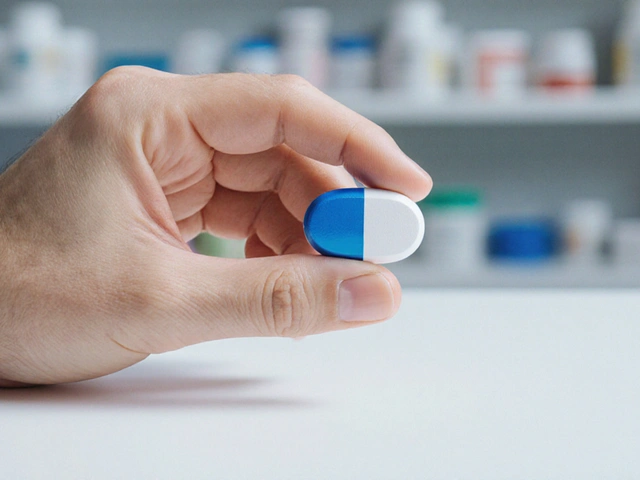UDCA Side Effect Risk Calculator
Personal Risk Assessment
When doctors prescribe Ursodeoxycholic Acid (UDCA), a hydrophilic bile acid used to treat certain liver and gallbladder disorders, they weigh the benefits against potential side effects. Understanding those risks helps patients decide whether the medication fits their health goals.
What Is Ursodeoxycholic Acid and Why Is It Used?
Ursodeoxycholic Acid (UDCA) is a naturally occurring bile acid originally extracted from bear bile, now synthesized in labs. It works by changing the composition of bile - making it less toxic to liver cells and reducing the build‑up of harmful cholesterol crystals. Physicians typically prescribe UDCA for conditions such as:
- Primary biliary cholangitis (PBC) - a chronic autoimmune disease that slowly destroys the small bile ducts.
- Gallstone dissolution, especially cholesterol‑rich stones that are small and radiolucent.
- Intra‑hepatic cholestasis of pregnancy, where bile flow is impaired.
- Some forms of non‑alcoholic fatty liver disease (NAFLD) when other treatments fail.
The drug is taken orally, usually 13-15 mg per kilogram of body weight per day, split into two doses. While many patients experience improvement, the medication isn’t risk‑free.
Common Short‑Term Side Effects
Most people notice only mild, temporary symptoms. The most frequently reported ones include:
- Diarrhea or loose stools - the bile acid can increase intestinal motility.
- Abdominal discomfort or cramping, often relieved by taking the dose with food.
- Nausea, especially when the dose is started too quickly.
- Fatigue, which may overlap with the underlying liver condition.
- Itching (pruritus), a paradoxical symptom because UDCA is supposed to relieve cholestatic itch.
These side effects usually appear within the first two weeks and tend to fade as the body adjusts.
Rare but Serious Risks
Although uncommon, some adverse events demand immediate medical attention. Below is a quick reference table that helps separate the everyday complaints from red‑flag warnings.
| Category | Symptoms | Action Required |
|---|---|---|
| Common | Diarrhea, mild abdominal pain, nausea, transient itching | Adjust dose or take with meals; usually resolves |
| Serious | Severe jaundice, dark urine, pale stools, rapid liver enzyme rise, allergic rash, unexplained fever | Stop UDCA immediately and seek urgent medical care |
| Very Rare | Pancreatitis, severe hepatotoxicity, gallstone obstruction despite therapy | Hospital admission; discontinue drug |

Who Is Most Susceptible?
Not everyone reacts the same way. Certain groups have a higher probability of experiencing adverse effects:
- Patients with advanced cirrhosis - their liver can’t process the drug efficiently.
- Those taking high doses (above 15 mg/kg) - the concentration in bile increases, triggering irritation.
- Individuals with a history of gallstone pancreatitis - extra bile acids may precipitate a stone.
- Pregnant women with intra‑hepatic cholestasis - while UDCA is often safe, close monitoring is essential.
Genetic variations in the bile salt export pump (BSEP) can also influence how the drug is handled, although routine testing isn’t standard yet.
Monitoring and Managing Side Effects
Proactive follow‑up makes a big difference. A typical monitoring plan looks like this:
- Baseline liver function tests (ALT, AST, ALP, bilirubin) before starting UDCA.
- Re‑check labs at 4‑6 weeks, then every 3 months for the first year.
- Track symptom diary - note any episodes of diarrhea, itching, or abdominal pain.
- If bilirubin climbs >2 × upper limit, consider dose reduction or temporary cessation.
- Assess fat‑soluble vitamin levels (A, D, E, K) yearly; UDCA can alter their absorption.
When mild side effects appear, simple strategies often work:
- Take the dose with a substantial meal - the food buffer slows absorption.
- Stay hydrated; oral rehydration solutions can offset diarrhea‑related electrolyte loss.
- Use over‑the‑counter antihistamines for itching, but discuss with your clinician first.
- Consider probiotic supplementation - some studies show it reduces UDCA‑induced gut upset.

Interactions with Other Medications and Supplements
UDCA shares metabolic pathways with several drugs, so interactions are possible. Notable ones include:
- Cyclosporine - both compete for hepatic transporters, potentially raising cyclosporine levels.
- Statins - rare reports of increased muscle pain, likely due to overlapping liver metabolism.
- Antacids containing aluminum or magnesium - can bind UDCA and lower its absorption.
- Fat‑soluble vitamin supplements - high doses may mask deficiencies caused by altered bile flow.
Always inform your healthcare team about herbal products such as milk thistle or silymarin, as they may amplify liver‑protective effects but also affect drug clearance.
Key Takeaways
- Ursodeoxycholic Acid is effective for cholestatic liver diseases and certain gallstone scenarios.
- Most side effects are mild (diarrhea, nausea, itching) and resolve with dose tweaks.
- Serious risks-rapid liver enzyme rise, jaundice, pancreatitis-require immediate discontinuation.
- Patients with advanced liver disease, high doses, or a history of gallstone complications need closer watch.
- Regular lab monitoring and a symptom diary are the cheapest ways to stay safe.
Can I take UDCA while pregnant?
Yes, UDCA is one of the few bile‑acid medications considered safe for intra‑hepatic cholestasis of pregnancy, but it must be prescribed at the lowest effective dose and monitored with liver function tests every 4 weeks.
How long does it take to see improvement?
Improvement in liver enzymes often appears after 3-6 months of consistent therapy. For gallstone dissolution, it may take 6 months to 2 years, depending on stone size and composition.
What should I do if I develop severe itching?
Severe pruritus can signal inadequate bile flow despite treatment. Contact your doctor; they may increase the UDCA dose, add cholestyramine, or explore alternative therapies.
Is it safe to combine UDCA with vitamin D supplements?
Generally yes, but monitor vitamin D levels. UDCA can change fat‑soluble vitamin absorption, so periodic blood tests ensure you aren’t over‑ or under‑supplementing.
Why did my doctor order a repeat liver panel after a month?
The repeat panel checks that UDCA isn’t causing hidden liver injury and confirms that the medication is lowering the enzymes that trouble you initially.





Danica Cyto
October 21, 2025 AT 20:18Reading through the details about Ursodeoxycholic Acid feels like peeling back the layers of an alchemical secret that the pharmaceutical elite don't want us to see. They present it as a miracle bile‑acid, yet the very mechanisms they extol-changing bile composition and calming cholestasis-hint at a deeper manipulation of our internal chemistry. If you think about bile as the river that carries waste, then tampering with its flow is akin to diverting a tributary in a hidden watershed. The side‑effects list, from mild diarrhea to the ominous specter of pancreatitis, reads like a warning encoded in plain sight. Most patients are told to accept the occasional itch as a small price for liver health, but who decides what is a “small price”? The tables of common versus serious adverse events conceal a subtle hierarchy: the serious ones are buried further down, almost as if the authors expect us not to look too closely. Genetic variations in the BSEP pump could make some people hyper‑sensitive, yet routine testing is left out of the protocol, perhaps to keep the market smooth. Monitoring schedules-labs at four weeks, then every three months-are feasible only for those with stable access to care, leaving a hidden population exposed. The suggestion to take the dose with a substantial meal sounds simple, but it also masks the fact that food can blunt absorption, reducing the drug's potency just enough to avoid detection of toxicity. Probiotic supplementation is touted as a remedy for gut upset, but could it also be a vector for introducing new microbial variables into the equation? Meanwhile, the interaction with cyclosporine, a drug used in transplant patients, illustrates how UDCA can alter the pharmacokinetics of other critical therapies, raising the question of whether the drug is truly benign. The mention of vitamin D absorption changes hints at a broader impact on fat‑soluble nutrients, possibly affecting bone health in subtle ways. And let us not forget the historical origin-extracted from bear bile-an emblem of a bygone era where wildlife was exploited for medicinal gain, now replaced by synthetic processes that still echo that same ambition. In the end, the decision to start UDCA is a negotiation between promised benefits and hidden costs, a pact that each patient must sign with full awareness of the unseen clauses. So before you swallow those capsules, consider the entire ecosystem of your body and the forces that stand to gain from your compliance.
Raja M
October 21, 2025 AT 22:53I hear you, Danica, and I think it’s crucial to weigh those hidden layers against the tangible benefits. While the drug can genuinely improve liver enzyme numbers, the subtle trade‑offs you highlighted shouldn’t be dismissed. A patient who feels the itch or the occasional cramp deserves a clear explanation, not just a bland reassurance. In my experience, a proactive symptom diary turns vague complaints into concrete data, letting both doctor and patient steer the treatment safely. So, keep the conversation open, ask for labs at the suggested intervals, and never settle for vague “it’s working” without numbers to back it up.
Robert Urban
October 22, 2025 AT 03:03UDCA can help but you gotta watch labs and symptoms it’s not a magic pill
Stephen Wunker
October 22, 2025 AT 05:00Sure, the article paints UDCA as a safe compromise, but let’s not ignore the fact that pharmaceutical companies love to market “benefits” while downplaying the rare yet deadly outcomes. Those “very rare” pan‑creatitis cases might be underreported, and the push for probiotic add‑ons feels like a revenue stream more than a scientific necessity. If you’re comfortable with a drug that can alter fat‑soluble vitamin absorption, great; if not, question why you’re being asked to swallow a chemically‑engineered bile acid in the first place.
Jhoan Farrell
October 22, 2025 AT 07:13Wow, this is super thorough! 😊 I’ve been on UDCA for a few months and the occasional diarrhea was annoying, but tracking my labs made me feel in control. If anyone’s feeling the itch, try a gentle antihistamine and keep your doctor in the loop. Stay safe! 🙏
Jill Raney
October 22, 2025 AT 09:26While the layperson’s summary suffices for general audiences, a nuanced critique must address the epistemic opacity inherent in the drug’s development pipeline. The omission of routine BSEP genotyping illustrates a systemic bias towards marketability over patient specificity. Moreover, the purported “low‑risk” label conveniently aligns with pharmaceutical stakeholders’ profit motives, a classic example of selective risk communication. One could argue that the periodic liver panels are merely a compliance checkpoint rather than a genuine safeguard. Thus, a discerning clinician should demand more granular data before endorsing blanket prescriptions. 🤔
bill bevilacqua
October 22, 2025 AT 11:23i think its overhyped, like, who really needs more pills??,,
rose rose
October 22, 2025 AT 13:20They hide the real numbers on purpose.
Emmy Segerqvist
October 22, 2025 AT 15:33Oh my god!! This article just blew my mind!! The sheer cascade of side‑effects, the secret genetic factors, the hidden labs-it's like a thriller!!! If you’re on UDCA, you need to read EVERY line, keep THAT diary, and never, EVER ignore a hint of jaundice!! Stay vigilant!!!